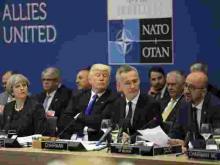NATO’s Summit belligerent escalation is a threat to world peace
Regardless of a later assessment, the conclusions of the NATO summit held in Brussels on July 11 and 12 confirm what the CPPC and the more than 40 organisations that joined the campaign “Yes to Peace! No to NATO! “said soon after its objectives were known, namely that this summit was aimed at “strengthening the warmongering intervention capacity” of this aggressive political-military bloc. This is, in fact, the serious and dangerous path to which the Portuguese Government has unacceptably associated Portugal.
This is clear from the outset by the reaffirmation of NATO's ability to intervene anywhere under any pretext: the identified "threats" and "challenges" cover virtually every situation and geographical point, beginning with Europe, the Middle East and North Africa; the Summit also decided to establish 30 mechanized battalions, 30 air squadrons and 30 combat vessels ready to go into action within 30 days.
One of the important aspects highlighted in the declaration is the intention to continue with the increase of military spending by NATO countries. The Summit's declaration expresses the goal that, by 2024, all countries spend 2% of their GDP on “defence”. It is worth remembering that in 2017 more than 1.7 billion dollars were spent on arms in the world and that the 29 NATO countries already account for more than half this amount.
Particularly serious is the position regarding the Russian Federation. Besides NATO's growing military presence on its borders, the accusations, warnings and threats launched by NATO in the Summit declaration are factors of tension. The distortion of reality goes so far as to accuse Russia of destabilizing and threatening NATO's "Eastern Flank”, as if it was not NATO that is increasingly deploying itself on the western borders of Russia. Promoting the tension and threats against Russia, with all the risks that this entails for international peace and security, NATO guarantees that the rapid intervention battalions in Estonia, Latvia, Lithuania and Poland, totalling 4,500 troops, are already fully operational.
NATO restates at its Summit its "nuclear vocation" and the strategic nature of its offensive missile systems, which are complementary, it reaffirms, to nuclear arsenals. It also reaffirms its opposition to the Treaty on the Prohibition of Nuclear Weapons.
The confirmation that the objectives of this Summit are the deepening of militarism and war shows the correctness and the need to continue the struggle for peace, for a fairer and fraternal world, carries out by the campaign "Yes to Peace! No to NATO! ".
July 16, 2018
CPPC's National Board
Escalada armamentista da Cimeira da Nato é um perigo para a paz mundial
Independentemente de uma análise ulterior, as conclusões da cimeira da NATO, realizada em Bruxelas, nos passados dias 11 e 12 de Julho, confirmam o que o CPPC e as mais de 40 organizações que com ele convergiram na campanha «Sim à Paz! Não à NATO!» afirmaram, assim que foram conhecidos os seus objectivos, nomeadamente, que tal cimeira visava reforçar a «capacidade de intervenção belicista» deste bloco político-militar agressivo. É esse, de facto, o grave e perigoso caminho apontado, caminho a que o Governo português, inaceitavelmente, associou Portugal.
Isto é claro desde logo pela reafirmação da possibilidade da NATO intervir em qualquer lugar sob qualquer pretexto: as «ameaças» e «desafios» identificados cobrem praticamente qualquer situação e ponto geográfico, a começar pela Europa, Médio Oriente e Norte de África; da Cimeira saiu ainda a decisão de constituir 30 batalhões mecanizados, 30 esquadrões aéreos e 30 navios de combate prontos a entrar em acção num prazo de 30 dias.
Um dos importantes aspectos que ressaltam da declaração é a intenção de prosseguir com o aumento das despesas militares dos países da NATO. Na declaração da Cimeira está expresso o objectivo de, até 2024, todos os países gastarem dois por cento do seu PIB na «defesa». Não é demais lembrar que em 2017 se gastou em armamento, no mundo, mais de 1,7 biliões de dólares e que os 29 países da NATO assumem já mais de metade desse valor.
Particular gravidade assume a posição face à Federação Russa. Para além da crescente presença militar da NATO junto às suas fronteiras, são igualmente factores de tensão as acusações, avisos e ameaças lançados contra este país na declaração da Cimeira. O desvirtuamento da realidade chega ao ponto de acusar a Rússia de desestabilizar e ameaçar as «fronteiras orientais» da NATO, como se não fosse esta a estar, cada vez mais, instalada nas fronteiras ocidentais da Rússia. Fomentando a tensão e ameaças dirigidas contra a Rússia, com todos os riscos que essa situação comporta para a paz e a segurança internacionais, a NATO garante que os batalhões de intervenção rápida instalados na Estónia, Letónia, Lituânia e Polónia, que somam 4500 efectivos, estão já totalmente operacionais.
A NATO reassume na Cimeira sua «vocação nuclear» e o carácter estratégico dos seus sistemas ofensivos de mísseis, complementares – reafirma-o – aos arsenais nucleares. Igualmente reafirma a sua oposição ao Tratado de Proibição de Armas Nucleares.
A confirmação de que os objectivos desta Cimeira são o aprofundamento do militarismo e da guerra, mostra a justeza e a necessidade de prosseguir a luta pela paz, por um mundo mais justo e fraterno desenvolvida pela campanha “Sim à Paz! Não à NATO!”.
16 de Julho de 2018
Direcção Nacional do CPPC

